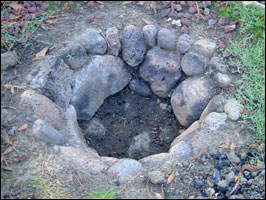
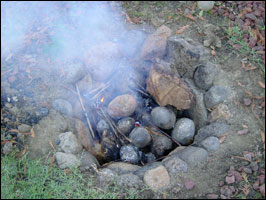
Anyone who has experienced a contemporary Hawaiian lu'au (feast) will find kalua pig a main part of the menu. Traditionally, the pig was cooked in an underground pit and served in plaited baskets made of coconut fronds or on large banana leaves. The shredded pork was just as tender and moist as a pork butt roasted in an electric or gas oven. The word kalua refers to the process of cooking in an earth oven (ka, the; lua, hole).
Throughout Polynesia, Melanesia, Micronesia, and even the Americas, traditional underground ovens have been utilized to cook and steam food. The Hawaiians used a pit oven, called an imu, to steam whole pigs, breadfruit, bananas, sweet potatoes, taro, chicken, and fish. The imu was essentially an underground steam cooker. Due to the amount of time and labor to prepare the imu, most earth oven cooking was done for group meals, festivities, or religious ceremonies.
To build an imu, a lua or round pit, about 2 feet to 4 feet deep with sloping sides, is dug into the earth. The diameter and depth of the lua will match the amount of food to be cooked. The pit must be large enough to contain not only the food, but the rocks and the vegetation. Keep the imu as compact as possible. Place the excavated dirt next to the pit. Later, it will be used to cover the imu. Next, gather kindling material, like twigs, small branches, and any other combustible tinder. Place the kindling material in the bottom center of the pit. Larger wood (preferably hardwood) is built around the kindling wood. Do not use wood that will impart an unpleasant taste to the food. Stones, about the size of a closed fist, are then positioned on top of the larger wood. Vesicular basalt stones are ideal for imu cooking. These porous rocks retain heat and are less likely to break. Stones that contain moisture, which causes the rock to explode when heated, should be avoided. The kindling wood is lighted and the blazing fire heats the pit and the stones. As the wood turns to charcoal, the imu stones drop inward on the hot coals. Firing time varies from 1 1/2 to 3 hours until the stones are at their maximum heat. The hot stones are then leveled out with a stick or wooden tongs to an even floor on top of the coals.
Since the cooking process requires steam and not dry heat, green plant materials are needed to create the steam. The Hawaiians utilized grass and leaves for their imu cooking. Some of the traditional plants were banana stumps, ti leaves, honohono grass, banana leaves, and coconut palm leaf (see the section on "Modern Adaptations on Imu Cooking" for plant substitutes). The common term used today to describe the green vegetation material and its use is hali'i, which is used to mean "to spread like the mat covering the floor".
Preparation is an important process to ensure a successful cooking. While the stones are being heated in the pit, gather and prepare any plant material you will need. If you'll be using banana stumps, they will have to be cut into sections smaller than the diameter of the pit. The sections are sliced lengthwise, either in half or quartered, depending on the size of the trunk. Then, the sliced stumps are pounded with a rock to break up the fibers and to release the moisture in the stumps. If a whole pig is going to be cooked, the skin and the inside cavity area are rubbed with a small amount of rock salt. When the stones are about ready, place all your food and vegetation materials near the pit. Also, lay your covering material next to the imu. Traditionally, the covering material before the final dirt cover were old lauhala mats or worn tapa cloth (see the section on "Modern Adaptations on Imu Cooking" for contemporary covering materials).
When the heated stones are ready, it is time to layer the imu with green vegetation, food, covering material, and dirt. The first layer of hali'i is laid directly over the hot rocks to prevent the food from being scorched and to create steam for cooking. If you have access to a banana trunk, use smashed banana stumps. Next, a second layer of hali'i is placed over the first layer. In Old Hawai'i, the green vegetation was ti leaves. This second layer is important in that it touches the food and adds flavor to the cooking meal. The food is placed on top of the ti leaves. If you are cooking a whole pig, a few hot stones are also placed inside the body cavity to insure the pig is well cooked. A third layer of hali'i covers the food. The old way used ti leaves with young, whole banana leaves on top. The covering material is then laid over the imu. The covering material must extend beyond the diameter of the pit's opening. This will keep any dirt from falling into the imu when the food is unearthed. The final layer is loose dirt, which is shoveled over the entire covering material to prevent any steam from escaping.
Estimating the time it takes to cook the food depends on the heat of the imu, the thickness of the hali'i, the kind of food, and the mass of the food. A large whole pig, in a good hot imu, may take from 6 to 8 hours of steaming time. When the cooking is done, brush away any loose dirt from the edges of the covering material. Remove the dirt from the lauhala mats or tapa cloth. Carefully lift off the covering material and avoid getting any dirt into the imu. Uncover the layers of hali'i and serve up your delicious meal.
Modern Adaptations on Imu Cooking:
For those who do not have access to any of the traditional
Hawaiian plants for imu cooking, there are vegetation substitutes
that you can use. Any plant that can provide steam, will not make
the food taste bad, and is not toxic can be used. You can get
some of these plant materials from the grocery store for free,
like lettuce trimmings or corn husks. Just ask your local grocery store and
tell them what you need for your imu cooking.
Below is a list of some of the plant substitutes:
1. Corn husks and corn stalks soaked in water
2. Cabbage leaves (be aware that your meat will have the taste
of cooked cabbage)
3. Lettuce
4. Thistle
5. Watercress
6. Cottonwood leaves
Contemporary materials may be utilized for the imu cooking.
1. Chicken wire to contain the pig. It makes removing a whole
pig from the imu a lot easier. Other foods can be wrapped together
with chicken wire.
NOTE: Do not use chicken wire that is made from galvanized steel. Avoid chicken wire that has a chemical or metal coating that will be toxic to your food.
2. Soaked burlap bags for the covering material. The soaked bags
can also substitute for some of the vegetation materials to provide
steam.
3. Plastic tarp or flattened cardboard boxes for the covering
material.
Photos of the imu cooking process:


Photo 1 -The opening of my lua, or pit, is 28 inches
in diameter and 18 inches deep. I decided to line the inside of
the pit with vesicular basalt rocks to retain more heat. Lining
the pit with stones is not necessary for a successful imu cooking.
An open dirt or sand pit would still work.
Photo 2 - The wood and stones are placed in the pit and
the fire was lit.
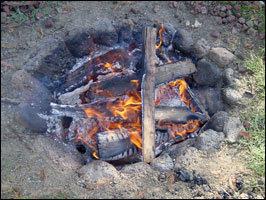
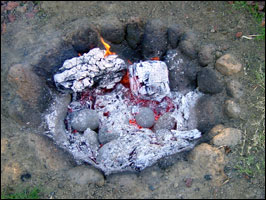
Photos 3 & 4 - More wood is added to the fire. The blazing fire turned into hot coals.
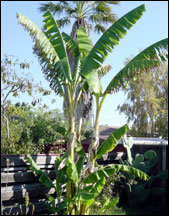
Photo 5 - While the stones were being heated, banana trees are selected for the steaming material.
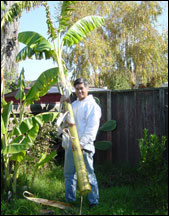
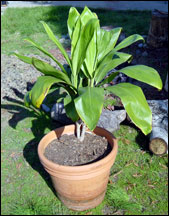
Photo 6 - Two banana trees are chosen and cut down.
Photo 7 - The ti plant that donated some of its leaves
for the cooking process.
This article was first published in Wilderness
Way magazine (Volume 11, Issue 1)
E-mail your comments to "Dino Labiste" at KahikoArts@yahoo.com
We hope the information on the PrimitiveWays website is both instructional and enjoyable. Understand that no warranty or guarantee is included. We expect adults to act responsibly and children to be supervised by a responsible adult. If you use the information on this site to create your own projects or if you try techniques described on PrimitiveWays, behave in accordance with applicable laws, and think about the sustainability of natural resources. Using tools or techniques described on PrimitiveWays can be dangerous with exposure to heavy, sharp or pointed objects, fire, stone tools and hazards present in outdoor settings. Without proper care and caution, or if done incorrectly, there is a risk of property damage, personal injury or even death. So, be advised: Anyone using any information provided on the PrimitiveWays website assumes responsibility for using proper care and caution to protect property, the life, health and safety of himself or herself and all others. He or she expressly assumes all risk of harm or damage to all persons or property proximately caused by the use of this information.
© PrimitiveWays 2013